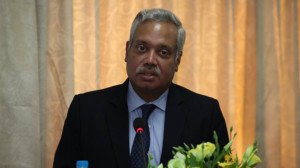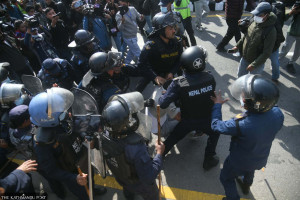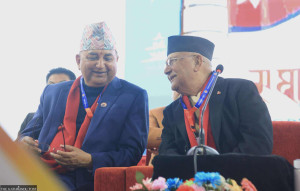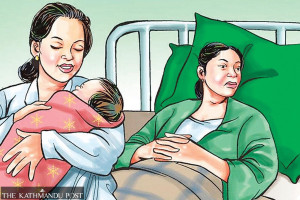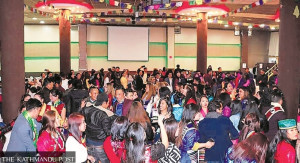National
Many earthquake-displaced families in Gorkha and Sindhupalchok are still languishing in huts
Ten years on, Dalits in Gorkha’s Barpak continue to suffer due to local divisions over reconstruction, while thousands in Sindhupalchok are unable to rebuild.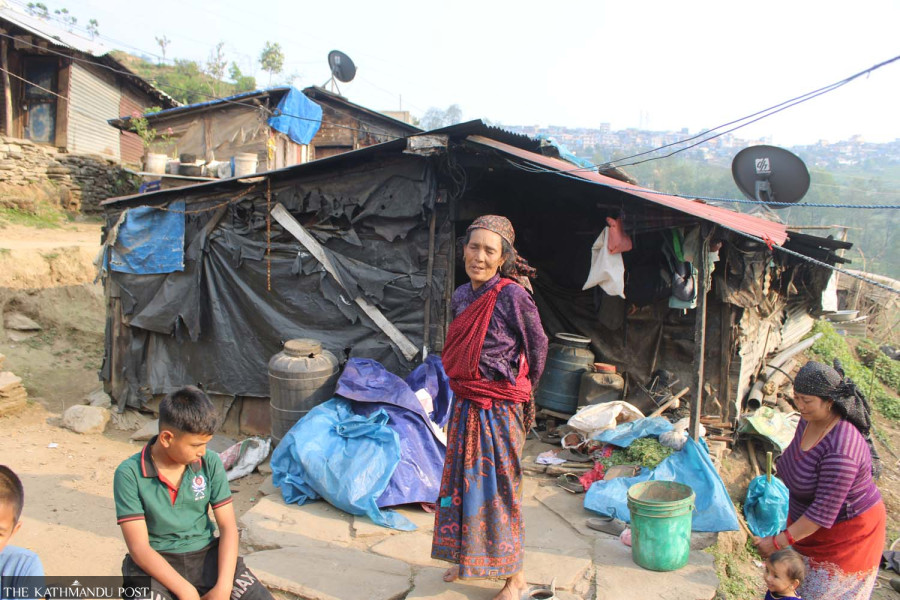
Hariram Upreti & Anish Tiwari
Ten years after the devastating Gorkha earthquake, Dalit families in Barpak are still struggling to rebuild their homes—caught between political division, administrative delays, and sheer hardships.
Seventy-year-old Kamala Kami lives with her daughter and grandchildren in a fragile tin-roofed shelter patched with an old tarpaulin provided as relief a decade ago. The roof leaks during rain, and strong winds threaten to blow it away. Kamala spends sleepless nights clutching her one-year-old grandson tight, fearing the roof might collapse. “I shiver all night and only find some warmth when the sun comes up,” she said. The village is located at 1,900 metres above sea level.
Kamala's family of six shares one shelter and they live on public land, constantly worried about being evicted. “Our old settlement in Gairigaun developed cracks and became uninhabitable,” Kamala said. “We don’t have land in other places, nor do we have any money to buy land. We live off whatever we can earn from farm labour.”
Like Kamala, many Dalit families in Barpak, the epicentre of the 2015 earthquake, remain in temporary shelters, plagued by health issues and lack of security. Purnima Sunar, another local, said she had to reroof her hut four times in 10 years. Her family of ten shares a cramped space, with no option to split up due to the lack of land. “We’ve been patching this shelter for a decade. Nobody seems to care about our suffering,” Purnima said.
After the earthquake, the families relocated to government land near the entrance to Barpak which was once used by the agriculture and livestock office. While some officials proposed building a ‘Living Earthquake Memorial Museum’ on the original Dalit settlement site, political disagreements among locals halted the plan.
Out of 24 Dalit households, only five returned to rebuild homes in the original village of Gairigaun, despite warnings from geologists that the area is unsafe. Most continue to reside on public land, demanding that the government formally allocate it to them as compensation.

In 2023, the Council of Ministers decided to provide alternative land to the community, approving the transfer of over six ropani (0.3 hectares) for resettlement. However, implementation has stalled due to political rifts. Some residents aligned with the CPN (Maoist Centre), and insist on rebuilding in the original location, while others led by Suk Bahadur BK, formerly a Maoist but now affiliated with the Nepali Congress, want land where they currently live.
This internal political division has left the reconstruction process in limbo. Many community members have received the first instalment of government aid. Yet, reconstruction efforts remain paralysed.
The chairperson of ward 1 of Barpak Sulikot Rural Municipality, Dhan Bahadur Ghale, confirms the old settlement is geologically unfit for habitation and acknowledges the delays caused by internal disagreements. “We had a plan to provide land and build a living museum, but the internal divisions halted everything,” he said.
Of the nearly 1,400 households in Barpak, just 24 are Dalit families and remain in lurch. As political friction deepens, the dream of safe and dignified housing for Barpak’s Dalit families remains distant—despite government decisions and a decade of waiting.
Likewise, many survivors in Sindhupalchok, the district with the highest death toll and one of the worst affected by the earthquake, are still living in temporary shelters. For 48-year-old Buddha Tamang from Jure in ward 9 of Bahrabise Municipality, life in a tin-roofed hut riddled with holes has become the norm. His ancestral home was destroyed and without safe land or financial stability, his family of five has endured floods in summer and biting cold in winter in a roadside hut by the Sunkoshi river.
Similarly, 65-year-old Nanda Kumari Khadka from Pangretol in Melamchi has spent years in a fragile shelter with her disabled son. The cold has worsened her health, and her son's disability allowance barely covers his medical expenses.
“We went hungry for many days. The meagre allowance provided to my disabled son is mostly spent on his treatment,” she said. “The earthquake destroyed the ancestral house. I don’t have money or strength to build a new one,” she lamented.
In Helambu’s Mahankal, Maya Tamang, 60, still suffers from injuries sustained when her house collapsed. She was buried under rubble for half an hour, leaving her unable to walk. “Old age and illness make life even harder now,” she said. Many earthquake survivors like Buddha, Nanda Kumari and Maya are still bearing the brunt of the devastating earthquake of April 25 and its aftershocks in 2015.
According to official records, the 2015 earthquake destroyed 66,000 houses in Sindhupalchok and claimed 3,570 lives. Though 84 percent of beneficiaries have since rebuilt homes, thousands remain displaced, highlighting the slow and uneven recovery process.




 7.12°C Kathmandu
7.12°C Kathmandu.jpg)
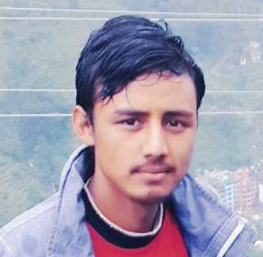

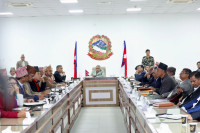



.jpg&w=200&height=120)

